There’s something truly magical about watching a child’s eyes light up as they witness the first sprout of a seed they planted, or the joy on their face when they pluck a ripe tomato from a vine they nurtured. Gardening with kids is not just a pastime; it’s a journey filled with wonder, discovery, and invaluable life lessons. Today, Jackleen Leed, PNW photographer and mom, is here to talk about introducing children to the art of gardening in this comprehensive gardening guide. From finding the perfect garden location to creating whimsical hideaways, this blog post is your comprehensive guide to making the experience of gardening with kids truly magical. Whether you’re a seasoned green thumb or a novice gardener, join us as we delve into the secrets of cultivating not just plants but also a lifelong love for nature and the outdoors in the hearts of your young ones.
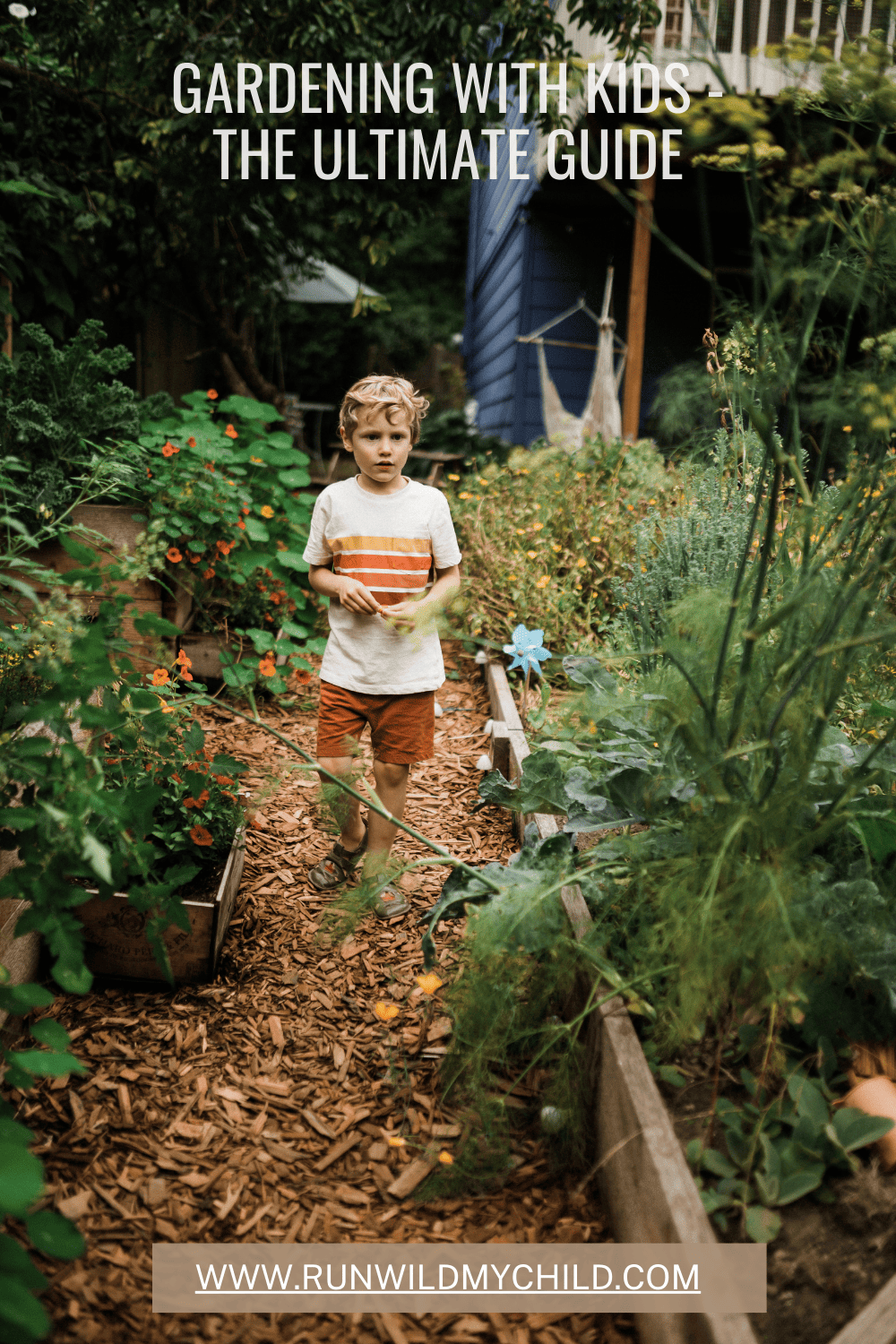
“Mud is the most poetical thing in the world.” ~ Reginald Horace Blythe
Gardening with kids for connection
Gardening with kids is a wonderful way for families to cultivate a deep connection with natural spaces that are well within reach. Children, like plants, need sunshine, rain, fresh air, and mud to thrive. By spending time with them digging in the dirt, placing seeds just so, and observing their growth, children learn a sense of responsibility for a piece of Earth they call their own.
Children who grow up connected to and feeling responsible for nature become stewards of the planet. Gardening is a great way to establish that connection. It’s also an amazing time for kids to connect with their big people.
And let’s face it, children aren’t the only ones suffering from nature deficit disorder. We could all use a little more time outside nurturing plants and nurturing our own souls.
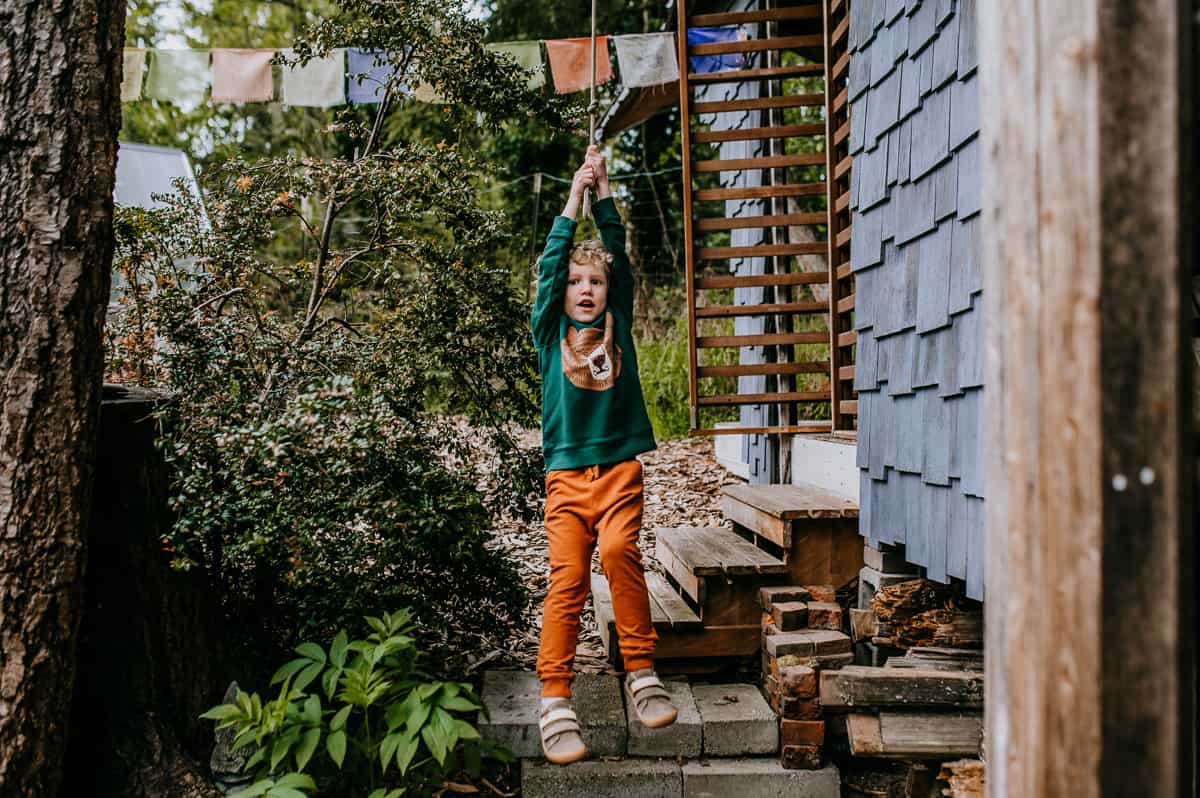
Climbing and swinging helps build trunk strength and are fun backyard activities to include when gardening with kids.
Benefits of gardening with kids
There are loads of benefits to getting kids in the garden beyond taking in the ample fresh air. Kids learn through experiencing the world around them. Botany, zoology, ecology, and environmental science are much more effectively taught in the garden than behind a school desk. It’s incredible how sophisticated our little learners can be when the learning is done in the correct context.
Child health and physical development
Children who learn to grow their food are much more likely to eat it, as well. Have a picky eater? Get them to grow something and watch their innate curiosity trump their skepticism of all things green. But, the health benefits go beyond the dinner plate.
Our bodies move differently in wide-open spaces. Children develop best when learning to navigate unstructured environments like those that can only be provided by the outdoors. Swinging and climbing build strong trunks. Balance is fostered by log hopping. Raking and digging yield upper body strength.
Perhaps best of all, time spent outdoors is not time spent behind a screen or *cough* time spent fighting about being behind a screen.
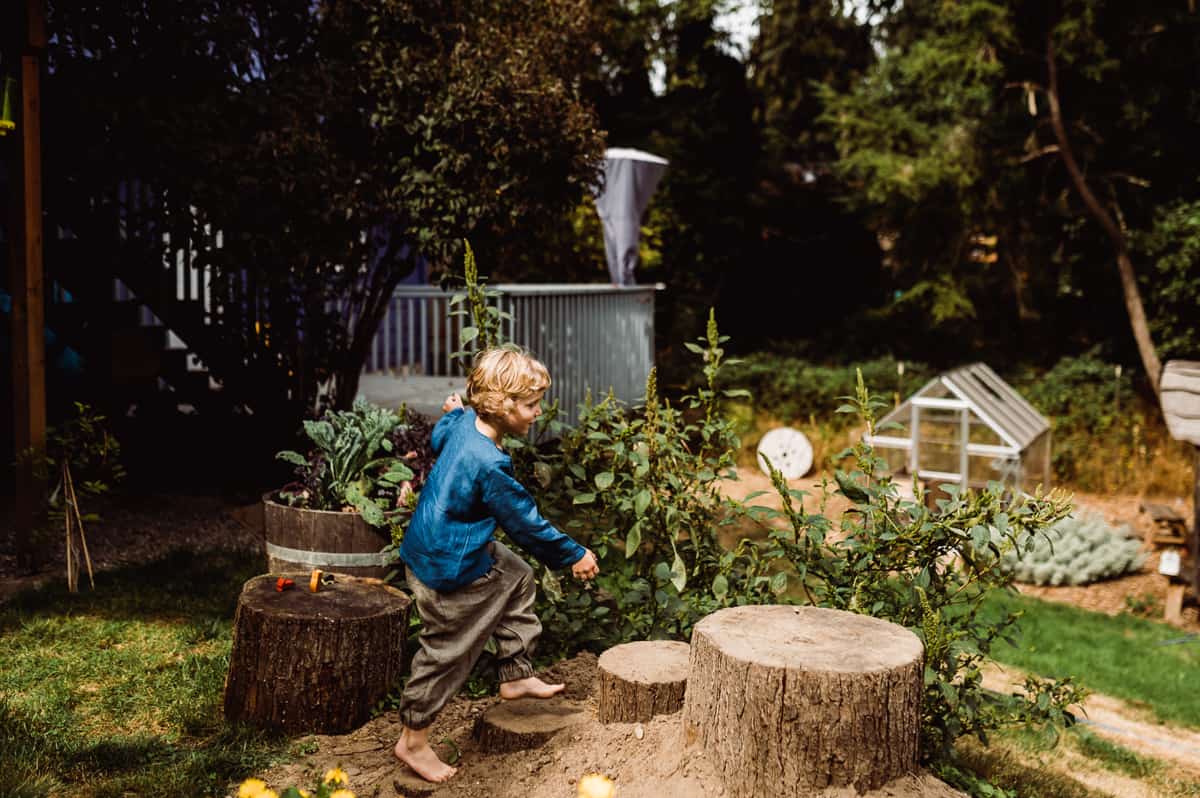
Log hopping is great exercise, and logs add a little whimsy to an outdoor garden space.
Problem-solving and life skills learned through gardening
Gardening teaches life skills. There isn’t a gardener in the world who hasn’t at least once in their life encountered a problem that needed solving. Gardening with children teaches problem-solving, teamwork, observation skills, and organization.
Kids encounter various challenges in the garden, from dealing with pests and diseases to deciding on the right amount of water and sunlight for their plants. These challenges require them to think critically, come up with solutions, and adapt their strategies as needed. Additionally, gardening teaches kids the value of teamwork. Whether they are gardening with family members, classmates, or friends, they must collaborate to achieve common goals. Tasks such as planting, weeding, and harvesting require coordination and cooperation. Working together in the garden not only fosters a sense of shared responsibility but also helps kids understand the significance of teamwork in achieving success.
Gardening teaches patience
Want your child to grow up to be successful? Have them grow alongside a garden!
Foundational research at Stanford by Walter Mischel and colleagues has shown that the ability to delay gratification is strongly correlated with success later in life. All gardeners know that gardening requires patience and persistence. You can nurture your child’s ability to delay gratification, and they will reap the benefits throughout their entire lifetime through gardening.
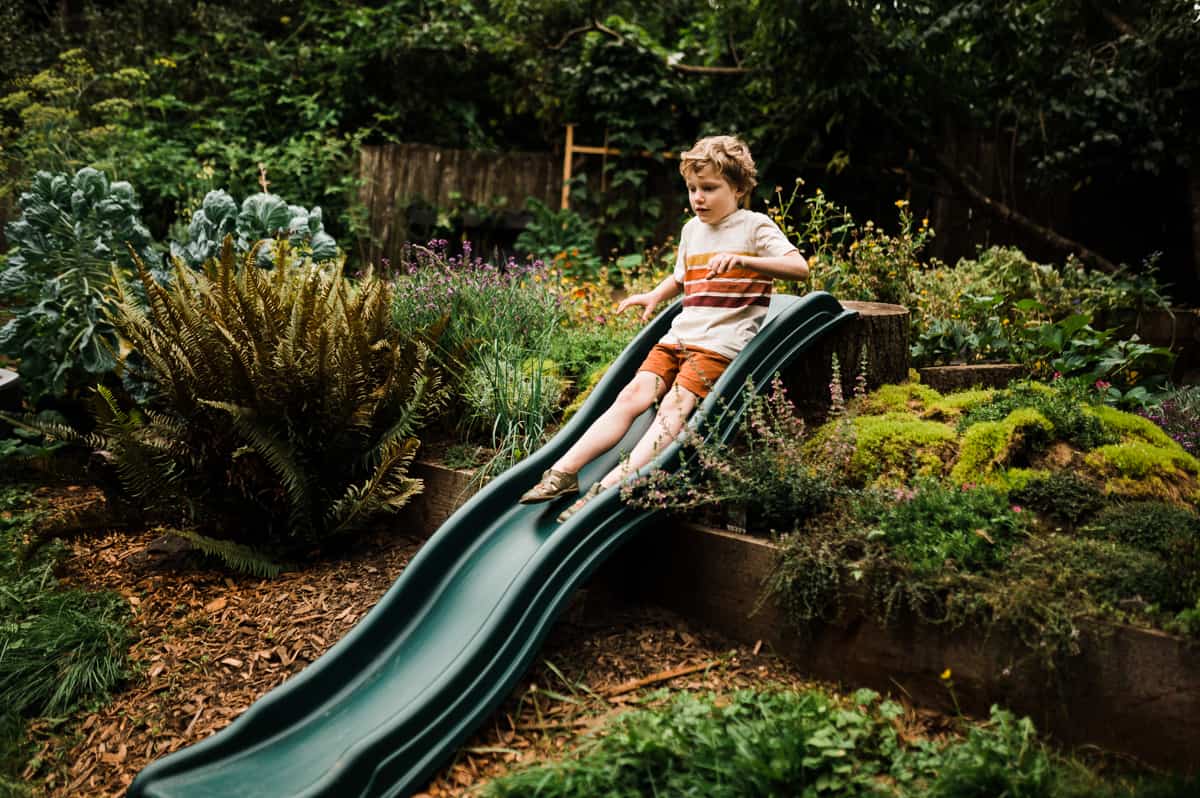
Adding a sliding board to a raised bed can go a long way in increasing the fun factor!
The ultimate guide to gardening with kids
Have I persuaded you to get outside with your kids? Leave perfection at the door (there’s no place for it when kids are involved). Just get messy and have fun. You may even learn a thing or two along the way!
But just in case you aren’t sure where to begin, here’s a guide about all the ins and outs of gardening with the little ones in your life. You’ll learn how to add whimsy and magic to outdoor spaces, how to design garden spaces with kids in mind, basic gardening know-how (e.g., finding your zone, choosing plants that will grow, soil preparation, and all about compost), teaching moments that can be had along the way (STEM in the garden anyone?), and arts and crafts for the colder winter months (you can take a gardener out of the garden, but…).
So let’s dig in, get dirty, and grow something.
Select a garden spot and get started
The right garden space can make or break a garden. That said, gardening can be accomplished nearly anywhere and everywhere. I’ve had tiny balcony gardens in the heat of Arizona, to raised beds in the Pacific Northwest. I rarely have the perfect South-facing plot with amazing sun and good drainage.
If you have a spot like that, by all means, get digging, but don’t let a lack of the “ideal” spot stop your gardening dreams from being realized. Truth be told, plants are tough and life finds a way. Plus, a good deal of the fun with gardening comes from experimenting and observing the results. You may be surprised, and that learning will not be lost in next year’s garden.
Companies like Vego Garden make modular raised beds that can be configured in loads of different ways. This gives so much more flexibility for garden spaces that are tight or awkwardly shaped. They even have kids’ beds and in-ground worm composters to add the good stuff back into your soil. They get bonus points for being so beautiful!

Modular beds grant extra flexibility in the garden space. Of course, don’t expect squash to be contained by anything unless you’re growing vertically.
Consider hardiness zones
When choosing the right spot for your garden, keep some basics in mind. For instance, you can find your hardiness zone here. Use your hardiness zone to choose plants that can survive year-round in your area. Hardiness zones are most important with perennial plants, though, as many plants that you place in a spring or summer garden shouldn’t be expected to survive the winter months. Still, it’s nice to have some plants come back year after year! Using native plants is also a safe bet, as native plants have already evolved to thrive in their respective environments.
Growing seasons
When choosing annual plants, like many of the vegetables that grow in summer gardens, you’ll want to pay attention to your area’s growing season. That is the length between the typical dates of the first and last frosts. Use these as a guideline for what you can grow, as each plant has a number of days from the time the seed is planted before it can be harvested (you can usually find this right on the seed packet). If your growing season isn’t long enough, you’ll never get to harvest before the first frost sets in. Don’t let all the charts keep you from taking chances or experimenting, though! So much of gardening is learned only through trial and error.
Accessible spaces for children
Probably the most important factor to consider when choosing the right spot for your garden is ensuring that your garden space is accessible to your children. Involving them in selecting the growing space gets immediate buy-in from them and sparks enthusiasm for the project.

Keep your garden accessible to children, and everyone will reap the benefits.
Getting kids involved in plant selection
Consulting kids about what to garden is as important as where to garden. Beyond hardiness zones and growing seasons, certain plants are better than others at keeping kids engaged. For example, creating a foraging garden that includes plants that are good for grazing, like snap peas and cherry tomatoes, as well as herbs like mint and superfoods like moringa, encourages children to sample what they’ve grown and gets them excited about the prospect of harvesting. Let your kids each pick a type of plant to try growing. They’ll be much more invested in the outcome (and likely to eat it), if they were involved in the process.
Afraid your thumb isn’t green enough, but want an easy win? This post will give you a great start with five veggies that are easy for kids to grow.
Consider creating theme gardens
Theme gardens can be a lot of fun. Below are some examples of types of gardens your child might be interested in growing.
Pizza garden
What kid doesn’t love pizza? Have them grow their very own toppings and watch their green thumbs and their palate take off. Pizza gardens might include tomatoes, peppers, eggplants, onions, garlic, artichokes, spinach, basil, and oregano.
Salsa garden
Salsa is my favorite food group so this one might be more for me than my kiddo. A salsa garden might include cilantro, garlic, hot pepper, onion, sweet bell pepper, tomatillo, and tomato.
Soup garden
Soup gardens are great for when the seasons start to change. Luckily, most of the contents are ready to harvest just when you might be craving a hot pot of it on the stovetop. A basic soup garden may contain garlic (basically every garden contains garlic), green beans, kale, chard, sweet corn, potatoes, onions, winter or summer squash.
Salad garden
Want your kids to eat the green stuff? Have them grow it! Salad gardens may contain beets, carrots (root veggies are especially fun to harvest since it’s like digging for buried treasure!), cucumber, lettuce, nasturtium (pretty edible flowers make magical fairy salads), radish, spinach, sweet bell peppers, and tomatoes.
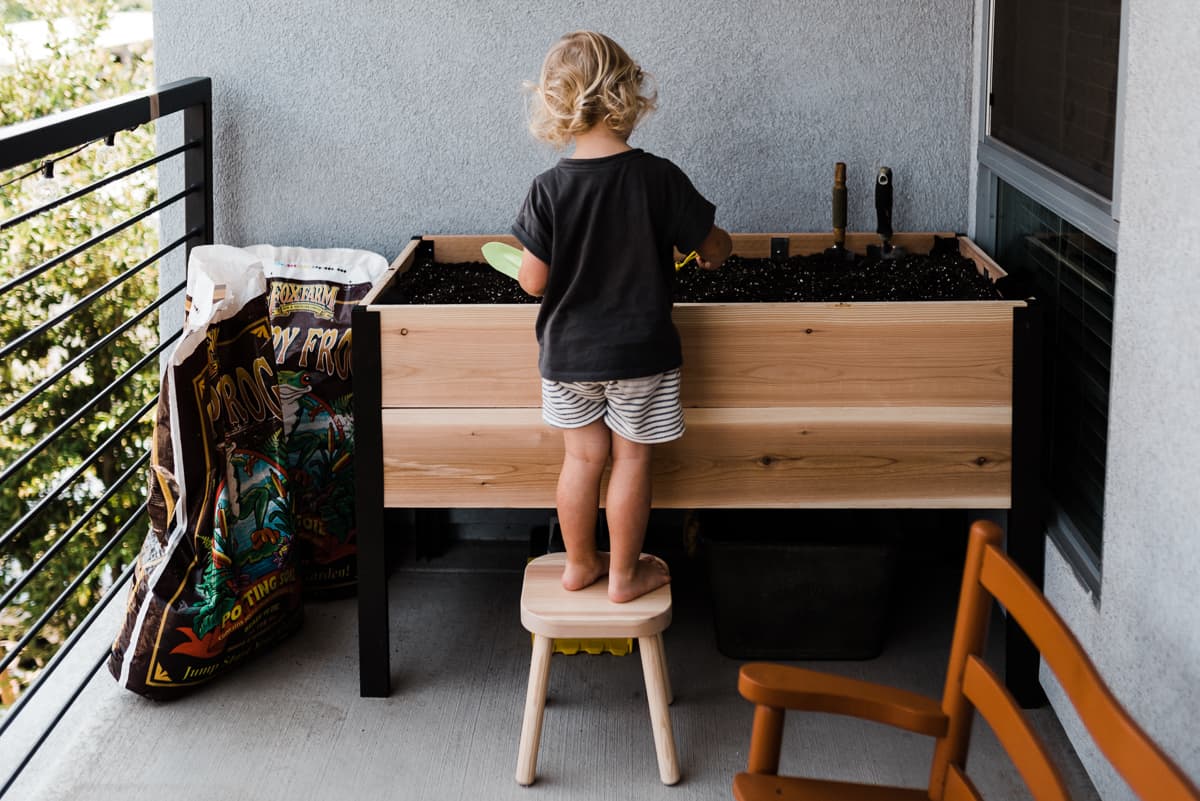
Gardening with kids can take place in all kinds of spaces. Here a child tends to a small balcony garden.
Three Sisters garden
This is a great garden to grow and can be coupled with storytelling! Corn, beans, and squash are known as the Three Sisters and are central to Native American agriculture and folklore. The corn provides tall stalks for the beans to climb. Beans, like other legumes, are nitrogen-fixers adding it to the soil. The squash plants grow as a ground cover, keeping the soil moist and controlling weeds. All three store well and can be used as food year-round. The book “In the Three Sisters Garden” by JoAnne Dennee contains some beautiful stories to pair with planting a Three Sisters garden.
In the Haudenosaunee tradition, all three types of seeds were planted together in a mound. Planting a Three Sisters garden is a great introduction to companion planting, which is when plants are grown near together for the benefit of one or more. Companion planting can be a natural way of pest control, can help plants grow bigger and stronger and increase pollination, and can even make certain fruits and vegetables taste better. Here’s a great resource to learn more.
Potion garden
This one is as useful as it is magical. Your little witchlings will appreciate a space where they can harvest ingredients for any magic they may be conjuring. And you’ll be able to create an apothecary for your family at the same time. Some great medicinal plants to include are calendula, chamomile, comfrey, horehound, lavender, lemon balm, peppermint, and sage. Lemon balm and lavender make a child-friendly and soothing tea to have before bed. Calendula is amazing at healing diaper rash and other minor skin irritations.
A butterfly or pollinator garden
Vegetables shouldn’t have all the fun! Creating a garden with pollinator-friendly plants will increase the presence of beneficial insects in your yard and garden space. A pollinator garden is also great for any fruits and veggies that you do have planted, as it attracts pollinators to your yard where they can find your vegetables and pollinate those as well.
But, pollinator gardens are fun in their own right. Butterflies are beautiful and honey and bumble bees are fun to watch. Kids love observing insects. This is a great opportunity to witness an entire life cycle in the backyard! Hummingbirds may even stop by. Most of all, creating a pollinator garden helps creatures that we depend on by giving them a safe food source.
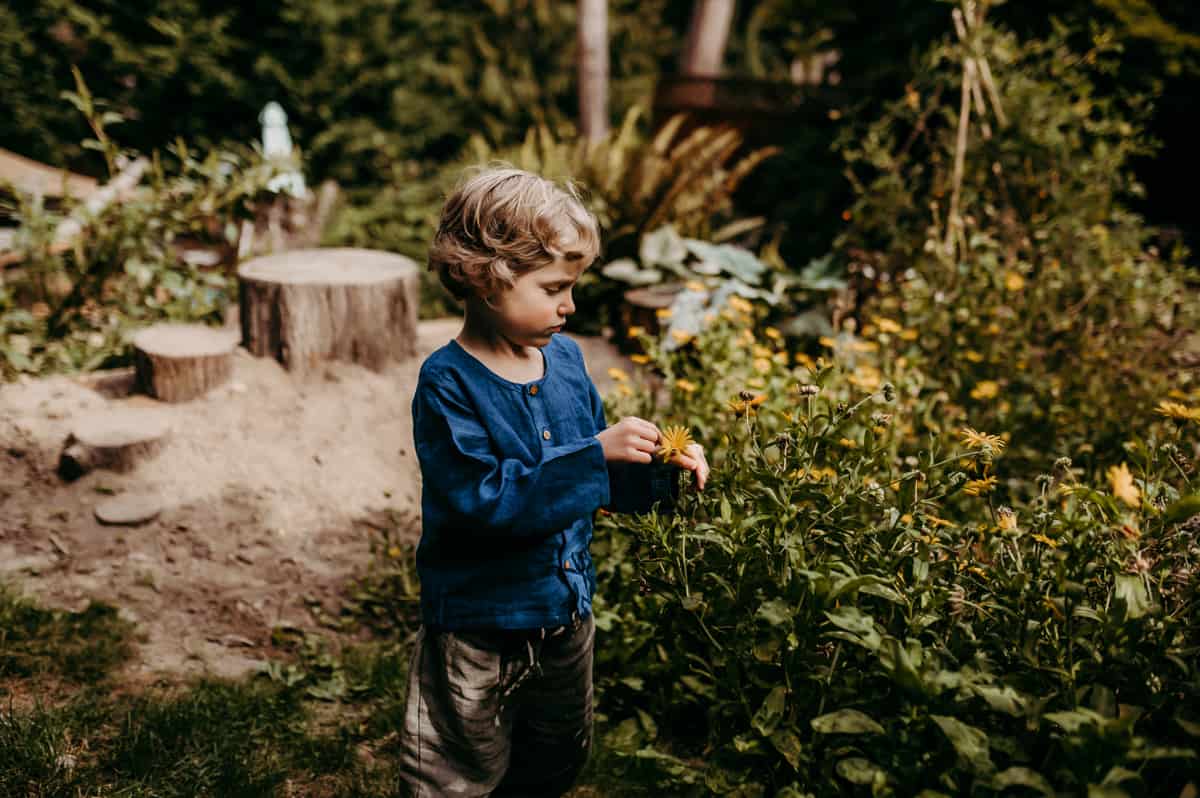
This calendula patch is perfect for creating soothing ointments and yields ample ingredients for kids’ potion-making.
Soil preparation
Preparing the soil is a crucial step when gardening and sets the foundation for a successful and enjoyable experience. Well-prepped soil provides the necessary nutrients, aeration, and drainage that plants need to thrive, offering children the opportunity to witness the direct correlation between soil health and plant growth. Moreover, involving kids in the soil preparation process is a valuable educational experience, as they learn about the importance of soil composition, organic matter, and pH levels, all of which are fundamental concepts in the world of agriculture and environmental science.
Composting
Gardens need nutrients, and that’s where composting comes in! Kids are inherently interested in the transformation of things. Teaching kids about compost is a great way to capitalize on these interests. Start by setting aside a second compost bin next to yours that is just for them. They can add their own food scraps to it and observe how it changes over time. Your little scientists may even want to record their observations.
Kids love playing in the dirt, and will likely be equally as fascinated in the process of how dirt comes to be. Try a composting experiment to bring the transformation front and center. Replicate a small compost pile inside a plastic bottle to create a compost soilarium (instructions can be found here).
Here’s a fantastic list of children’s books all about composting to read more.
Build a worm farm
Want to take composting and your garden’s health a step further? Consider creating a worm farm! The only thing that kids may love more than dirt are the things they find in it, including wriggly worms. And the worm castings they create are amazing soil amendments. All you need is a plastic storage container with a lid and some basic things that can be found around the house.
Drill 10 or so small holes in the sides and bottom of the container. The holes allow air in and excess moisture out. Worms like to be moist, but not soaking. Make sure to cover the holes with a screen so your worms don’t get out. Fill the container halfway with strips of newspaper (children can cut the paper into strips), which serve as a comfy bed (and a snack) for your worms. Moisten the newspaper with a spray bottle. Add red wriggler worms.
Add food scraps to the newspaper (fruit and veggie peels, coffee grounds, pasta, tea bags, and foliage trimmed from the garden make great additions, but don’t add dairy, oil, or meat). Place the bin on a tray or pan in a warm spot out of direct sunlight. Add food and check on it regularly.
Eventually, worm castings will start to build up, though it can take a while. Once you have enough castings, use a spoon to scoop them out and add them to the soil around the plants in the garden. An indoor worm bin (using red wrigglers) can be started at any time of year and is a great winter activity to get soil amendments ready for use in spring and summer planting.
Create a soil horizon
Learn about the native soil in the areas you wish to plant by doing this educational activity with your kids. Creating a soil horizon provides information on how often you will need to water your garden and what kind of plants will grow best there. It’s also super easy!
All you need is a glass quart-sized jar with a lid, a hand trowel, soil, water, and a soil-type chart for making observations and comparisons.
Start by filling the jar 2/3 full with water. Take a soil sample using the trowel to remove the top inch of soil from a small area where your future garden will live, then dig out soil from underneath and fill half the jar with soil, topping it off with water. Seal the jar and have your kids take turns shaking it vigorously. Then place it somewhere it won’t be disturbed for at least 24 hours.
Encourage your kids to peek at it every once in a while and to observe any changes while using their eyes and not their hands. After 24 hours, you should see different layers of soil at the bottom of the jar. The very bottom layer is sand, with silt on top, and clay on top of that. Compare your soil horizon to a soil chart to identify what kind of soil you have in your garden. Feel free to repeat this experiment in other areas of your yard, or wherever you wish to grow something.
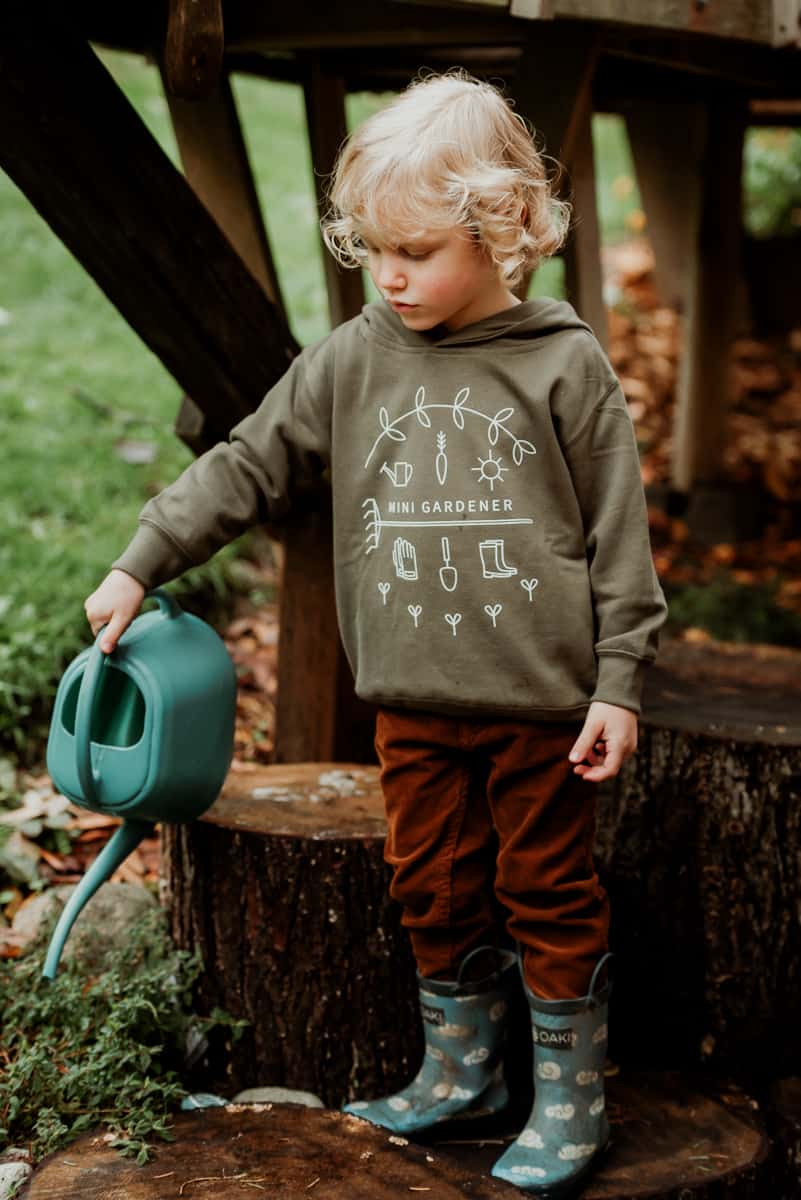
Having kids water plants is a great way to involve them in age-appropriate garden tasks.
Getting kids involved in garden tasks
Involve children in soil preparation by having them use their tools to loosen it, adding their own compost for nutrients, and creating holes where tiny seeds will go. Guide them in planting seeds at the right depth and spacing, but don’t be a perfectionist about it!
If you are transplanting seedlings, teach them to be gentle with the plants. Let them give the plants a drink and encourage them to monitor their growth on a regular basis.
The best way to avoid garden pests is to catch and remove them early, and little gardeners can use their eagle eyes to find them. Introduce ladybugs in the garden to naturally control pests like aphids. Planting flowers for pollinators and parasitic wasps can also control pest populations naturally.
Connecting with nature
Remember that one of the overarching goals of getting children in the garden is to cultivate a connection with and stewardship of nature. Choose garden chores that align with specific children’s ages and guide them as they take on new skills. But leave lots of room for unstructured play in the garden.
All work and no play will result in your child quickly losing interest. Kids were created to play and this medium fosters the most effective learning. So incorporate plants that can handle some foot traffic in play areas. Use borders to protect delicate saplings and to remind your own little saplings where their feet belong. And let loose in the garden a bit. Gardening is supposed to be a stress reliever after all!
Quiet your inner gardener and let your child guide you in taking chances. I let Remy plant any seeds or seedlings he wanted to in his plot. Some of the seedlings looked quite scraggly (which is why they didn’t make it into my raised beds), but low and behold, they all took off when he got them into the ground. So take some chances and quiet the critical gardener who “knows best.”

A lightweight child-sized garden rake is perfect when little hands need to push mulch and soil.
Adding whimsy and magic to your outdoor garden space
Adding a touch of whimsy and magic to outdoor spaces can transform them into inviting realms for children to play and explore. Incorporating elements like colorful, oversized garden ornaments, fairy lights, and hidden nooks can stimulate their imagination and create a sense of wonder. Enchanting pathways, secret garden doors, and miniature fairy houses can turn a simple garden into an enchanting world where kids can embark on exciting adventures and imaginative quests. These elements not only encourage outdoor play but also foster creativity and a deep appreciation for the natural world, allowing children to connect with the magic of nature in their own backyard.
All things mud
If your child loves to dig (*enthusiastically raises hand*), create a digging-only bed where they can dig and play in the mud without harming seedlings. Add some earth mover toys and a pile of rocks and sticks for additional textures and to create mud gnome homes (note: larger rocks are better for staying out of little mouths).
A mud kitchen is a great place to mix potions and make mud pies. Check out the book “Mud Pies and Other Recipes” by Marjorie Winslow for inspiration. Encourage your little ones to build fairy houses with natural objects so the pixies will help care for the garden.

Mud kitchens allow kids to make messes in all the right places!
Places to hide
Incorporating living structures like squash tunnels, sunflower houses, and bean teepees into your garden can transform it into a captivating and imaginative haven for children. These living structures not only add a sense of enchantment to the garden but also provide fun places to hide, play, or curl up with a book. Squash tunnels create cozy hideaways where kids can explore the lush foliage and vibrant blooms while staying shaded from the sun. Sunflower houses offer a natural, sun-dappled retreat where young readers can immerse themselves in books amidst towering, sunflower walls. Bean teepees, with their climbing vines and leafy canopies, provide secret alcoves for imaginative play and offer a sense of seclusion within the garden’s green embrace. These living structures not only inspire a love for gardening but also nurture a child’s sense of adventure and wonder in the great outdoors.
Creature features
Include bird houses, bat boxes, feeders, and bee baths for lots of creature viewing and additional connecting with nature. You may wish to create a sit spot where your child can engage in the mindful practice of sitting quietly and observing. Have them select the spot, but it should be in a location that is good for observing nature with varied and interesting things to watch. Your child can return to the same spot as frequently as desired and note how wildlife changes throughout the year. This is a great practice to couple with nature journaling.
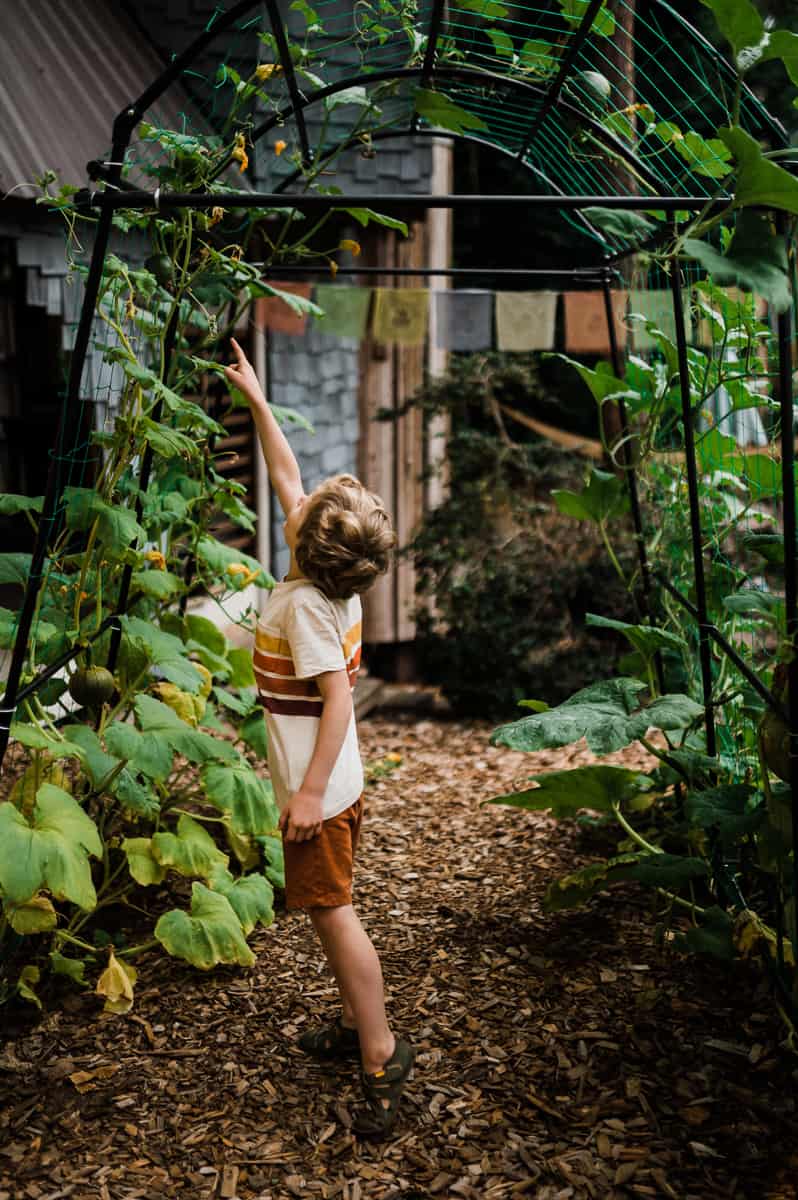
Squash tunnels are space-efficient and a fun place for kids to hide.
Garden safety tips for kids
Don’t forget about safety! Always supervise children when they are in the garden, especially younger ones. Keep a close eye on them to prevent accidents and ensure they are following safety guidelines.
Teach kids how to use garden tools properly. Better yet, invest in small, lightweight child-sized versions of trowels, rakes, and watering cans to make gardening more fun and to get your kids invested as well. Ensure that any chemicals or fertilizers are stored out of their reach. This is a great time to go over proper hand washing, too.
And finally, teach children not to touch or ingest any plants without your guidance. Some plants can be toxic if ingested or cause skin irritation upon contact. Familiarize yourself with the plants in your garden and educate your children about any potential hazards.

Sunflowers are beloved by children and pollinators alike!
Garden arts and crafts
Crafts are a great way for your artsy child to put their mark on their garden. Have your child plant seeds in the shape of a design in the garden and watch their artwork literally come to life!
Let your child paint the sign for their garden to instill a sense of pride and ownership. Kids can create plant markers by painting river stones. Garden games can also be created with the use of river stones and acrylic paint. For instance, paint rocks as ladybugs and bumble bees for a fun game of tic tac toe on a tree stump.
When it’s especially cold and wet outside, inside garden crafts abound. Create mosaics by using a piece of cardboard, some glue, and some randomly- (or carefully-) placed seeds of different shapes, colors, and sizes. Envelopes can be decorated and labeled to collect seeds from the garden for planting the following year.
During the winter months, your budding artist can create a plant collage using an old seed catalog, scissors, glue, and poster board, to use while planning and dreaming up spring’s garden.
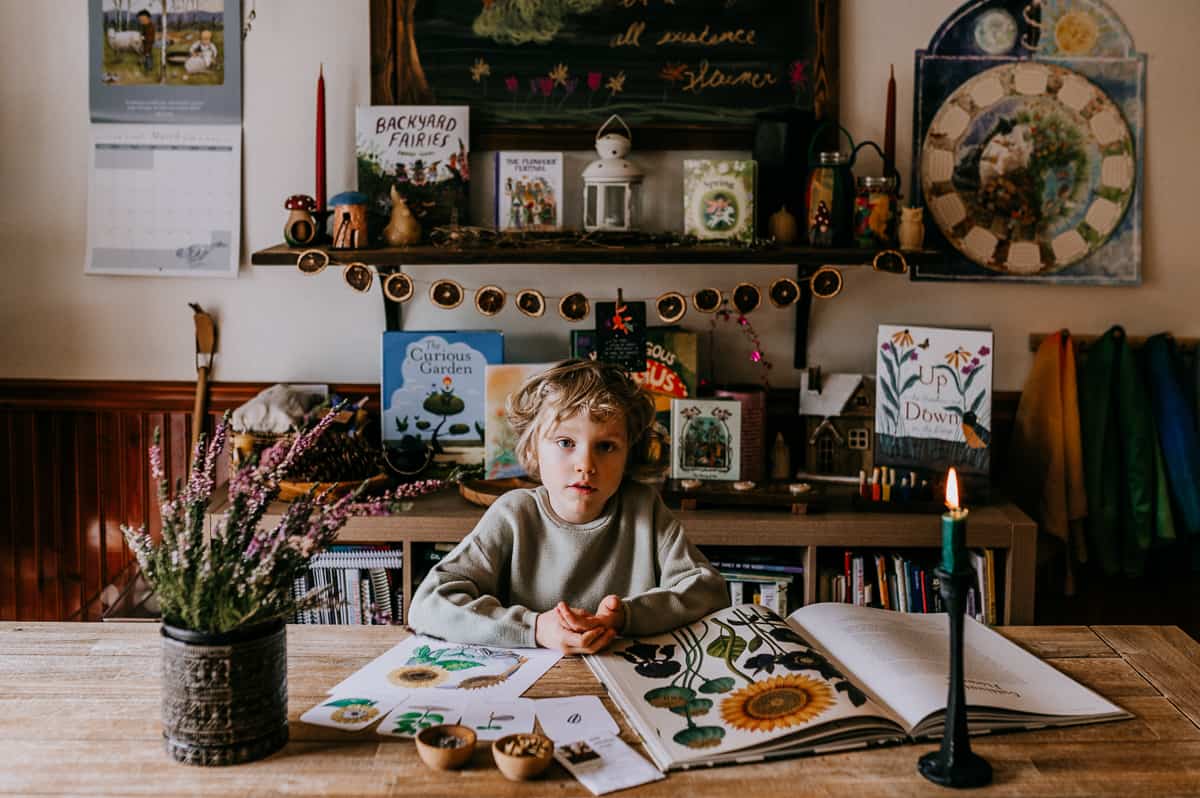
Seed mosaics and garden-themed books bring the outdoor learning inside when the weather is inclement.
Live your garden
Weave gardening into your everyday life, much like brushing your teeth. Collect some flowers for a small vase on your child’s play table. Let them pick the lettuce that will go on the sandwiches you make for lunch. Grow a pumpkin that will be carved for Halloween or made into a pie at Thanksgiving. Create a pizza garden that is utilized on Friday movie nights. When the garden is dormant in the wintertime, spend that time cozy in front of the fire with a seed catalogue dreaming about what will go in your plots in the spring. Have a garden party. Find garden-themed books and read them all year long (this list has some amazing titles, as does this one).
Focus on your child’s passion and let them do some leading. What is their favorite thing to eat? Grow that! And don’t forget the very little ones. Just being alongside you in the garden is enough to feed their interest for the coming years as their abilities allow them to participate more and more. It’s never too early to start!
Above all else, get outside, nurture, and be nurtured.
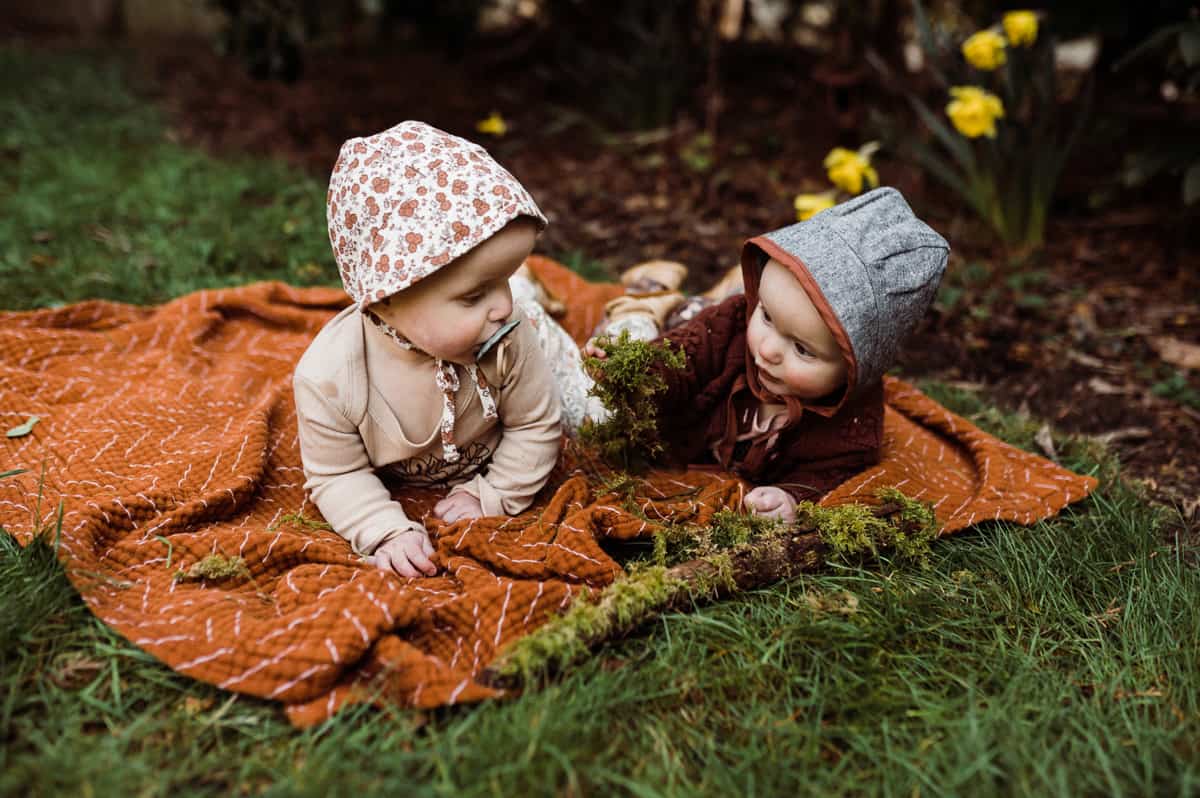
Little hands love new textures and gardens provide all that and more!
Do you garden with your kids?

About the author
Jackie grew up in central Pennsylvania but is currently enjoying island life in the Salish Sea with her two teens, a pre-schooler, and identical twin baby girls. She specializes in soul-centered outdoor elopements on wild pieces of Earth, as well as soulful, nostalgic, and cozy storytelling photography for families wishing to reconnect with the Earth and with each other.
Jackie is a former forest preschool teacher with a Ph.D. in developmental psychology who whole-heartedly believes that Reginald Horace Blythe was right when uttering the words “Mud is the most poetical thing in the world,” and loves to spend her time in the thick of nature, usually with bare feet. Her greenhouse is her happy place. She also believes that children are big philosophers in little bodies and that we would all be better off walking through life as they do, with our eyes, ears, and hearts open to it all. To that end, she wishes to share photography as a means to live more fully and intentionally in each moment and in nature. Mostly, she just wants her children to grow up with a sense of wonder, to wander, and to have a strong passion for protecting this planet.
You can find more from Jackie in the following locations:
Instagram: @raising_little_naturalists
Website: Wild Women Wandering
RWMC posts: Jackleen Leed








1 comment